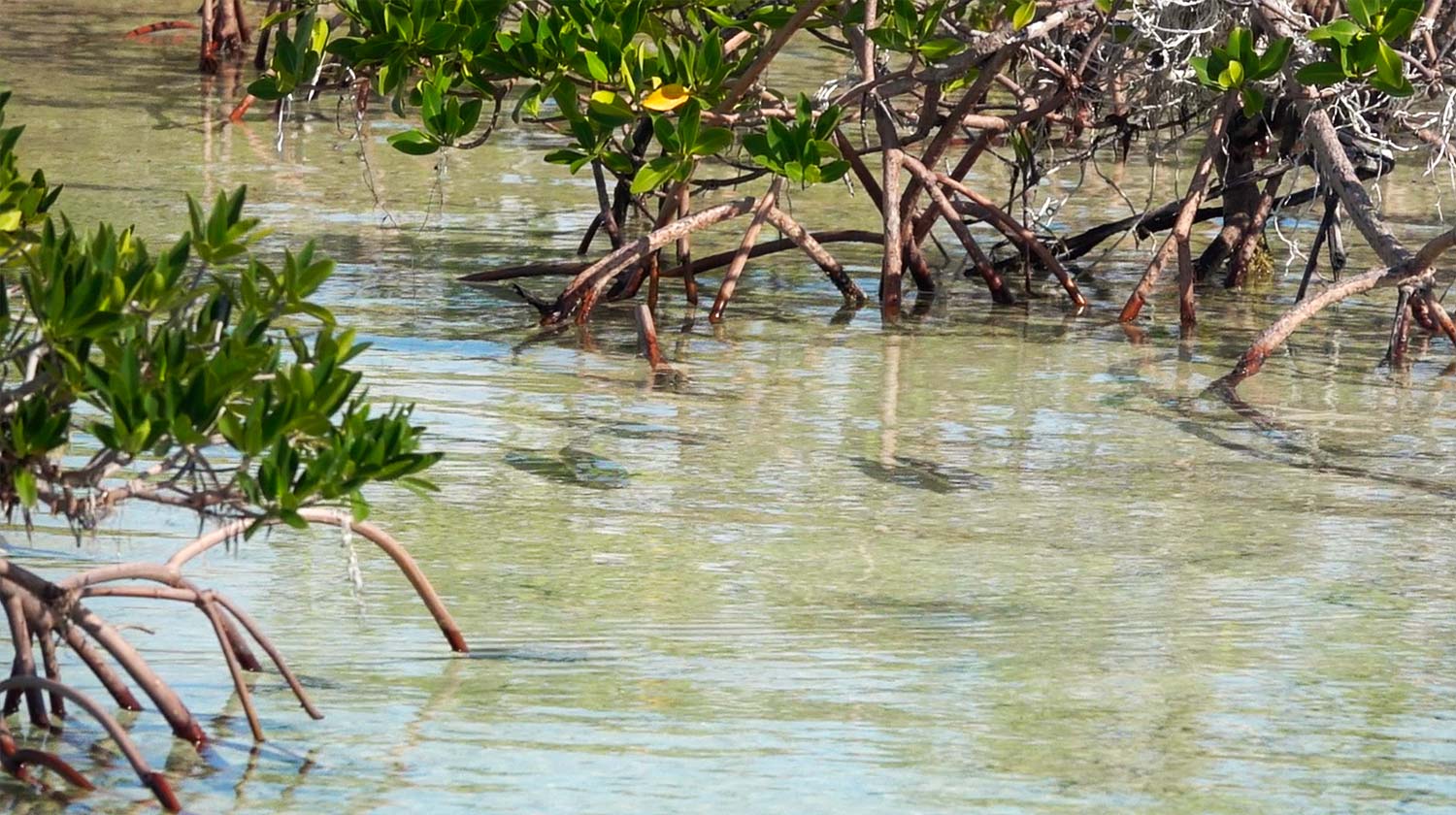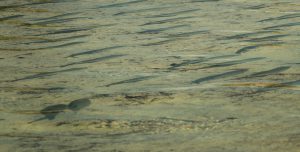
Photo by Louis Cahill
There’s more to spotting fish than having good eyes, so don’t assume you can’t see them.
I’m used to being told I have good eyes. Among anglers, that means the ability to spot fish. In truth, I have never had good eyes. I’ve worn glasses my whole life and had to remember where I put them at night because I couldn’t find my glasses, without my glasses. Thanks to the great prescription program at Smith Optics, I’ve always had good fishing glasses and could see well enough. It wasn’t until I developed aggressive cataracts, last year, that I really started to struggle.
It’s no secret that I do a lot of bonefishing. They don’t call bonefish the ghosts of the flats for no reason. Their natural camouflage makes them very difficult to see. When I started losing my sight, my greatest fear was that I would no longer be able to spot bonefish. This fear only got worse in the weeks following my first lens replacement surgery. My vision was pretty poor at first and even now, a month past my second surgery, it isn’t what I’d like. I’m confident that it will get to where I want it, but when I headed to Abaco for bonefish, I was pretty nervous about how I would perform.
It turns out I did pretty good. It was a huge relief to see my first bonefish, and even better to hear, “good eyes,” when I spotted a fish before my guide. Still, my new eyes are not what they should be and it taught me a few things about what it means to see fish. I see plenty of anglers give up on the idea that they will be able to see fish before they cast to them. If that sounds familiar, here are a few things to think about when you’re looking for fish.
You can actually find fish with surprisingly poor visual acuity.
Yes, it’s tougher when the image you see is not clear, but it’s doable. Seeing fish is more about knowing what you are looking for than seeing it clearly. There are tells that give fish away, even when your vision is not great. One of the easiest to pick up on is motion.
Most fish are in motion most of the time. Whether they are actually on the move or just using their fins to hold in current. Human eyes are great at spotting motion, even when the object in motion is blurry. Once your brain makes the connection between motion and fish, they start to pop out at you.
The fish has a little friend who gives him away, even if he is very still. Even if he’d like to, he can’t shake his shadow. The faint image of the fish is always accompanied by the more pronounced shadow. Well, as long as the sun is out. Our eyes are also very good at recognizing repetition of shape. The two identical forms traveling together are a dead giveaway.
If you have ever been flats fishing and found yourself questioning your guide, “Is that a fish?” only to hear “bottom,” as a constant reply, you may have wondered how to tell the difference. A chunk of grass or coral is attached to the bottom, so there is no space between it and is shadow.
There is also a kind of craft to looking for fish.
 A method of work. It’s very easy to get spacey on the bow and lose focus. If you’re trout fishing it’s just as easy to fall back on reading water and not take the time to look for fish. Either requires patience and focus. You have to break down the water you’re searching into smaller areas and search them methodically. Keep your head on a swivel and scan the water. It’s much better to come back to a spot you suspect might hold a fish, than to stare a hole in it. If you get tunnel vision you’ll miss a lot of fish. You have to stay sharp. Expect to see the fish. Picture him in your mind. Eventually, he’s going to be there.
A method of work. It’s very easy to get spacey on the bow and lose focus. If you’re trout fishing it’s just as easy to fall back on reading water and not take the time to look for fish. Either requires patience and focus. You have to break down the water you’re searching into smaller areas and search them methodically. Keep your head on a swivel and scan the water. It’s much better to come back to a spot you suspect might hold a fish, than to stare a hole in it. If you get tunnel vision you’ll miss a lot of fish. You have to stay sharp. Expect to see the fish. Picture him in your mind. Eventually, he’s going to be there.
Once you do find a fish, pay close attention to the visual image. Try to file it away in your catalogue of visual cues. Once you have that picture in your head, you are more likely to recognize it. I tell anglers who are new to bonefishing to look for old school Coke bottles in the water. That subtle color change and feeling of translucence is what bonefish often look like.
Having compromised vision absolutely makes sight fishing more challenging. I have found that, while I can still spot fish pretty well, I have lacked the vision to see them eat the fly. It has made timing my hook set more challenging. Though I don’t know that I’m missing that many fish, it can take me longer to seal the deal. That’s not going to keep me out of the game. Not even temporarily. If you are struggling to see fish because of compromised vision, don’t give up on yourself. We all struggle to see fish, especially when it’s new. Stick with it. Once you start to see them, you’ll find them everywhere. Sometimes it’s just about faith.
Want a deeper dive into how to spot bonefish?
12 Tips For Spotting More Bonefish
Louis Cahill Gink & Gasoline www.ginkandgasoline.com hookups@ginkandgasoline.com Sign Up For Our Weekly Newsletter!
I had cataract surgery/ lens implants three years ago. 20/20+/- in both eyes for distance but need readers in close. I had terrible distance vision before the surgery.
Straight from the heart advice, plain spoken. On a recent trip, some fine fish were boated, and I had even spotted few on my own. This gave me courage to ask my guide to take a stroll with my rod while I climbed the platform. A world of difference. By then we had advanced to cruising singles and doubles. I could see the big fish follow and eat the fly. Following the entire sequence was an experience etched my cells.
Great bit of info. I’m never able to spot trout and now I’m going to try a little harder. Thanks.
Great article. Just wanted to add an observation.
I find I can spot wildlife better than most of my family and friends. It comes from spending 1000’s of hours hiking, camping and observing. After a while it just became second nature to spot something that ‘just doesn’t belong ‘. I’m not looking for an animal or a fish. Just something that looks like it’s out of place.
Motion is a big factor, but beyond that, looking for a solid block of color, the white bands of a brook trout’ s fin, a pale tail wag in the current, a momentary flash, some piece of a fish rather than the whole fish. Once alerted by one of those images, fish seem to appear “out of nowhere”.
As you said, practice helps improve those skills, by expanding those mental images of something being “out of place”.
Thanks!
Great article. Just had both of mine done this month. Awaiting the healing resolution for Rx readers.
My experience in the military, doing a lot of hunting in my youth, and learning tracking have all taught me to (1) trust peripheral vision scanning and (2) learn to look for patterns that shouldn’t be there. They all help provide what you are looking for.
“while I can still spot fish pretty well, I have lacked the vision to see them eat the fly.”
that’s been my problem.. vitreous detachments in both eyes.
As Mike says between the peripheral vision and the instincts of decades, can still spot them somewhat, but the accurate detection of carp eats seems no longer possible. That means a lot of missed fish. Oh well new challenges.
Interestingly was fishing a #22 BWO last week, could see it on the water often enough that I could keep track of it even after losing sight contact. Nice.